The “Le Redoutable” was the world’s first steel-built central battery ironclad and started a new breed of capital ships for France in the 1880s. She however still had wrought iron armor. She was also the largest warship afloat when launched, rebuilt in 1894, and saw service until 1910 in the Mediterranean, Indian Ocean and the Far East where her career ended.
Background

The previous Colbert (1875)
The term itself, “ironclad”, was seemingly referring to a ship type appeared in 1858 (or even before according to authors), meaning iron was the primary material for protection (hence the “cladding”), not structure. Indeed if the French were first to launch a sea-going Ironclad, Gloire, she was still wooden-built, whereas the British Warrior class were the first entirely iron-built. Over the years, the French started to use iron for the structure and it was something common in 1870. However steel, which was known for millenias, was only available in small quantities for various objects and structures of limited size, but the industry was not able to deliver large plates made of steel, nor having a reliable industrial process yet to do so.
The French iron industry lagged behind Britain and Belgium in the years 1815-1830, and after 1850 still lagging behind Germany and Luxembourg. Its output was plagued by too many small and inefficient firms. However the German Siemens process was adopted, and Le Creusot became the French’s leading company for steel manufacturing. Sir Carl Wilhelm Siemens developed the “Siemens regenerative furnace” in the 1850s, a fundry process using a regenerative preheating with a reversible furnace flow, allowing an open-hearth furnace to reach temperatures high enough to melt steel.
In 1865, French engineer Pierre-Émile Martin indeed took out a license from Siemens and applied the process for making steel. The modified regenerative furnace was able to produce large quantities of basic steel with 50 to 100 tons and later special processes to make 250 or even 500 tons: The Siemens–Martin furnace. His process complemented rather than replaced the Bessemer process, but was slower and easier to control, also allowing large amounts of scrap steel, but refining a charge was an overly long process. In short, this gave an edge to France in 1870, and naval engineers were quick to take note, as steel had amazing structural qualities contrasting with iron.
The advantages of steel
The prospect here was to allow the production of very large, homogenous steel parts, not for protection, but structure, while wrought iron armour was stil used for plating and had in some cases wooden backing. Bessemer steel was favored by French metallurgists Gruner et Lan, but Martin found the Siemens process superior and obtained large financial support. After the first tests in 1864, his furnace was first operational in le Creusot (Franche-Comté in the east) -a 1781 company funded by François Ignace de Wendel-. Soon, the company became the main supplier of steel for the French Navy.
France was the first nation to start construction of a warship almost entirely made in steel. However let’s recall again steel at this point was still not usable for armor plates. Redoutable’s wrought iron armor plating, was completed by part of her exterior hull, also in iron rather than steel. But the steel produced was relatively “elastic”, not brittle, which was a well desired property for the structure. Moreover it had a superior strenght at equal weight, allowing to free extra weight for added protection, and that’s what made this ironclad unique.
Britain’s response

HMS Alexandra, rival of Le Redoutable
Britain tested the waters soon with the construction of two dispatch vessels, HMS Iris and Mercury, all-steel, laid down in 1875–1876. The Royal Navy lagged behind because of the trust placed in the British Bessemer process, which produced too many imperfections for large plating. On ballistic tests, it was found too brittle. The British also tested a combined wood and iron ‘sandwich’ armor on HMS Inflexible (1876).
Compound armor seemed the solution, by fusing steel with iron plates. This compound armor appeared by the 1870s for the turret of HMS Inflexible, and the whole armor on HMS Colossus (1882). At that stage, both French and German navies adopted the process, licencing the ‘Wilson System’ for fused armor.
Design of Le Redoutable (1871-73)
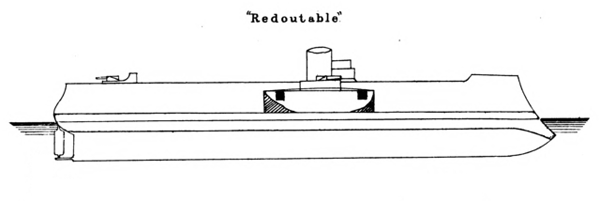
Silhouette on brasseys naval annual
It’s on 1871 that maritime engineer Louis de Bussy proposed to the Navy Minister (Ministre de la Marine) plans for a battleship made in steel, replacing iron as the primary protection material, and structure. Different thicknesses of steel were provided according to the specifications, reducing the draft. Plans were accepted in 1873 and followed by an order registered in an ambitious five years naval plan, including the Devastation class, Courbet, and the six coastal ships of the Tonnerre and Tempete classes.
The Battleship Le Redoutable was laid down at the same time as HMS Alexandra, also a very innovative central battery ironclad. Since the 1870 Swiftsure class, she was sheated in wood and copper, not iron, was about the size and tonnage of Redoutable, with heavier armament, innovative (but still iron) protection, and was the first ironclad with vertical coumpound engines, making her slightly faster than Redoutable at 15.09 knots.
Hull & general appearance
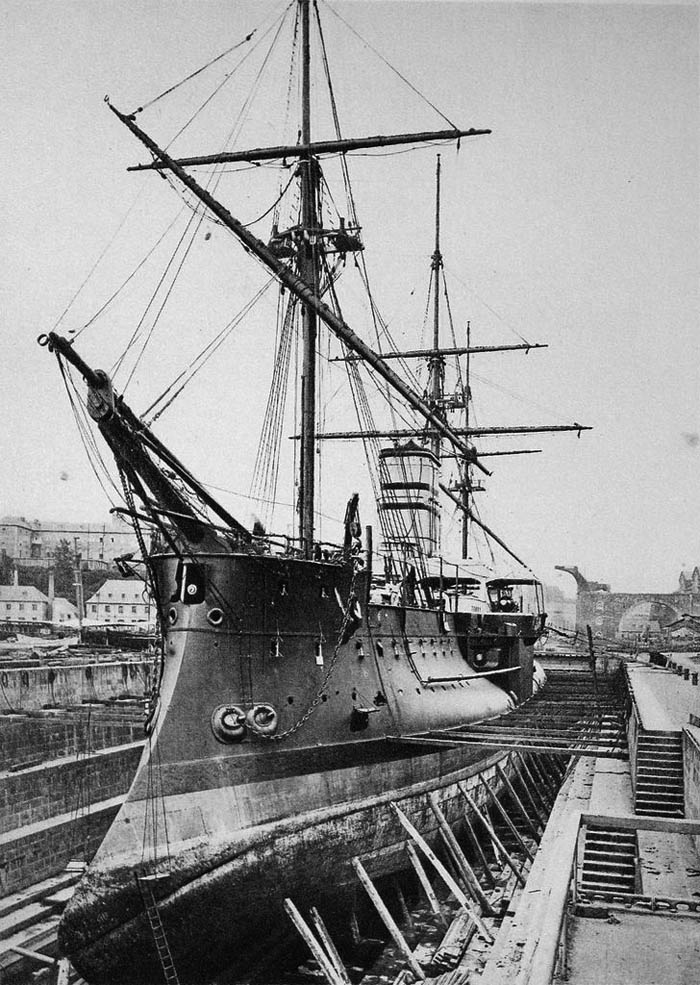
Redoutable in Brest’s drydock, by Neurdein
This new central battery ironclad saw a beam radically increased with the trademark “pear-shaped” section, or tumblehome which was tested then, assumed to increase stability as a gun platform and made a more predictible roll. She also had her draught reduced due to this increased buoyancy at the waterline.
The central battery was much shortened, with just four main guns mounted at its corners on rail to give them maximal arc of fire. The very marked tumblehome combined to the reduced central battery meant only one main gun could fire at any time.
As said above for the first time, steel was used for most of the hull construction, notably bracing and armour, though wrought iron covered still much of the structure. There was a double bottom but watertight longitudinal bulkheads. The steam steering engine was placed above water. Metacentric height was remarkably low at 0.85m.
-As rarer in 1879 she was still fullly rigged, with some 2,230 m2 of sail. To be precise, her square rig had a total sail area of around 2,033 square metres (21,880 sq ft) up to 2,700 square metres (29,000 sq ft) with all flying bonettes. This later was reduced after her first major refit and she ended as a barquentine, with much reduced and simplified sail.
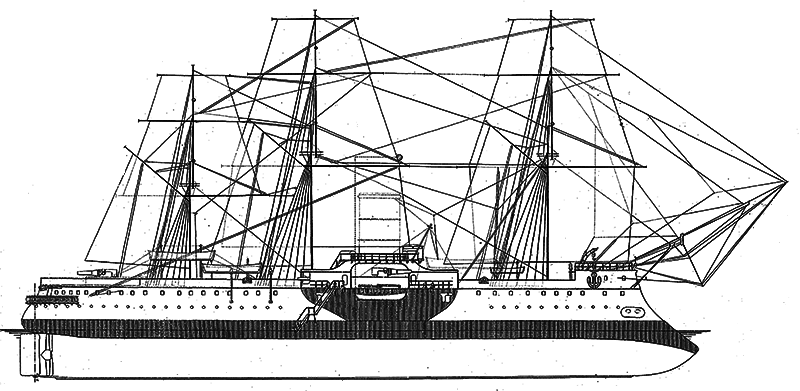
Redoutable as completed, NVPD
Ultimately she was rebuilt a last time, gaining two thick standard military masts giving her an imposing appearance.
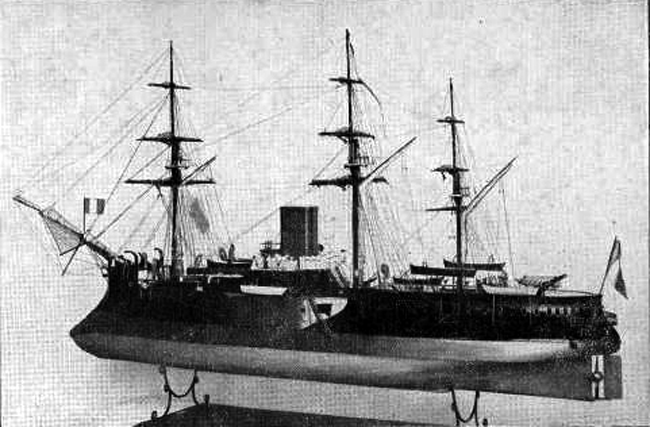
Yard Model of the Redoutable, now at the Paris Marine Museum
Armor scheme
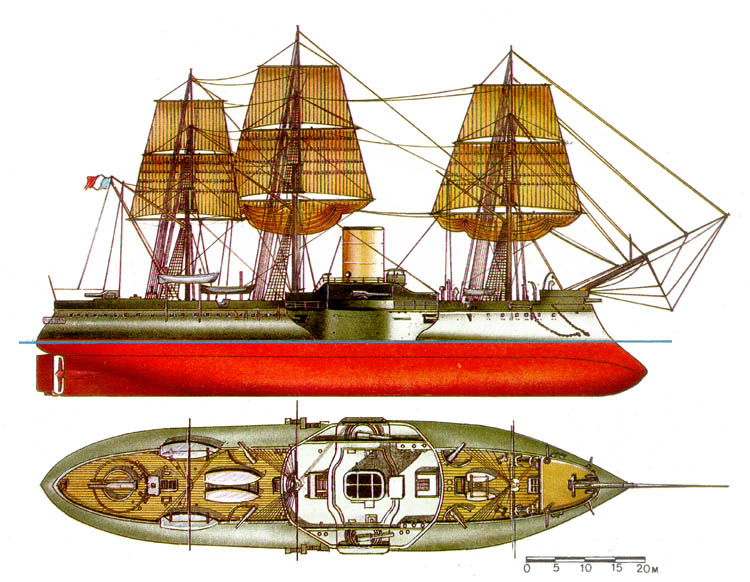
Russian Color Illustration
Le Redoutable had a complete belt, which ran from 1.5m (4.92 ft) below to 1.5 m above the waterline. This main belt was 350 mm amidships (13.7 in), tapering to 220mm (8.66 in) forward and to 230mm (9 in) aft, as well as at the lower edge. This was not a steel belt, just classic wrought armor as the rest of the ship. Steel was used for construction only as its properties at the time were not judged sufficient to provide an adequate peropective plating.
The armour of the battery upper edge was situated 5.8 m above the waterline. It was composed of a 60mm (2.3 in) deck, at the belt upper edge outside, the battery. There was no armoured roof.
Powerlant
Her machinery was not revolutionary. She followed the previous practice, but with not a single, but two Horizontal return connecting-rod compound steam engines, mated on two shafts, fed by eight oval boilers; In total, she developed 6,700 ihp (5,000 kW) (vs. 4,700 PS; 3,400 kW (4,600 ihp) on the Colberts). As a result she was the fastest French ironclad ever built, reaching 14.5 knots (26.9 km/h; 16.7 mph) on trials, reduced to 14 in normal conditions, as the Colberts. The new tumblehmome shape and greater beam (19.76 instead of 17 m) made it possible to place two steam engines side by side. She was reboilered in 1894 (see later).
Armament
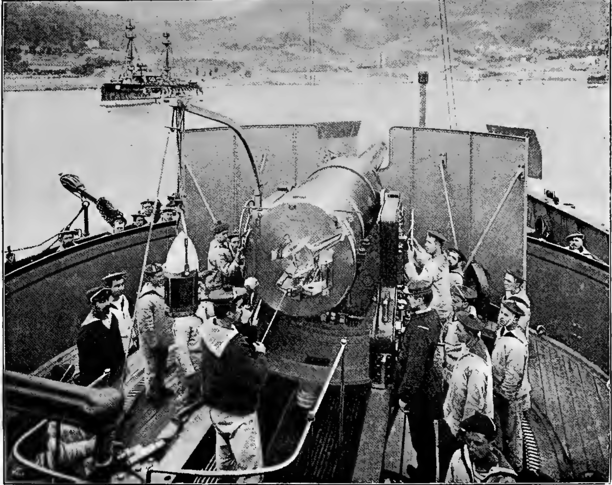
Deck 27 cm behind its gunshield aft.
Main: Seven 27 cm (10.6 in)
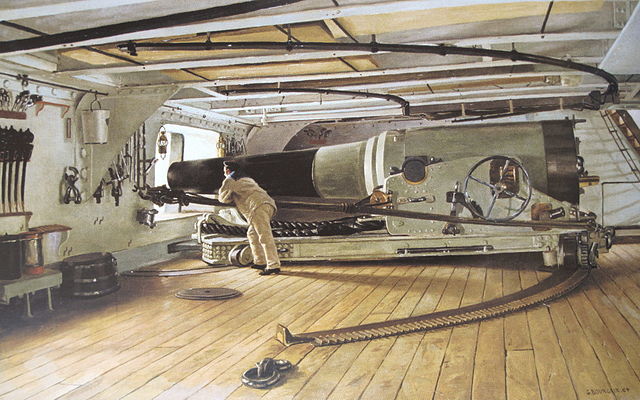
27 cm Model 1870
Porthole broadside gun installation, Model 1870 gun
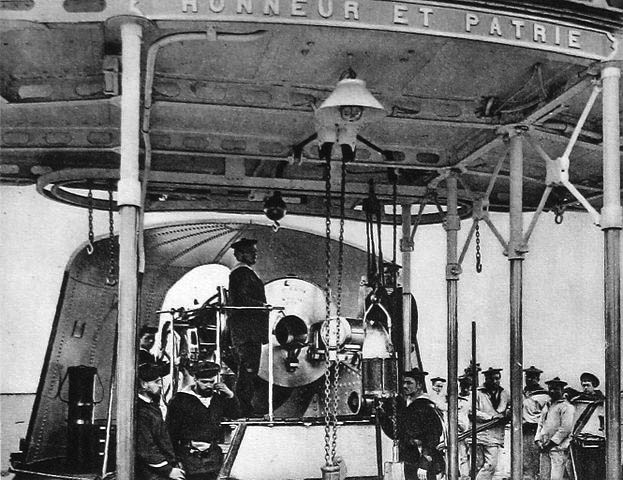
Canon 27 cm Model 1875, modified (Photo by Neurdein).
The four battery guns were of a lighter, lower velocity pattern than the four unarmoured upper deck ones later added, which were mounted under the forecastle, at the stern and on either beam in half-barbettes. it’s hard to find good informations about these ordnance. Navweaps only starts with the 274 mm/40 model 1896 and /45 model 1887. However a site about Sere de Riviere Fortifications which also used it states:
The Canon de 27cm had a cast jacket, with A type steel tube. The barrel weight was 30,200 kg, 8 m 266 long for an exact caliber of 274,4 mm. It used a Console and spring latch closure for the breech.
The carriage was the Modèle 1888 with front pivot, weighting 46 tonnes. It allowed a depression/elevation of -6°/+25°, and for the battery guns on rails, 180° arc of fire. Max range was 18,500 meters (20,230 yards). Muzzle velocity was 590 m/s max (645 yds/s) with a shell of 216 to 350 kg (476 – 771 Ibs).
Secondary: Six 13,8 cm (5.4 in)
The Model 1870 introduced a caliber that would see a very long service in the French Navy. Navweaps has infos on the 138.6 mm model 1884 but not before. The last 138.6mm/50 was the model 1929 found on several large destroyers. The M1870 was about the same mechanically as the 270 mm gun.
Tertiary*: Seven 100 cm (3.9 in)
The 138 mm guns were slow, and later replaced by 100 mm Canet guns in 1894, equivalent which had twice their rate of fire, placed on the upper deck. Magazines for the battery guns were noted overheated by the machinery spaces below, something which was corrected for subsequent ironclad designs. Designed in 1889, the Schneider 100 mm Canet was introduced in 1891 was a modern and rapid piece of ordnance, widghting 1,700 kg (3,700 lb)
for a total lenght of 4.6 m (15 ft 1 in) and barrel length of 4.4 m (14 ft 5 in). Caliber 45, it fired a fixed QF ammunition 100 x 869 mm. The recoil used a Hydro-spring recuperator and the breech was a screw system. Rate of fire on average as 10 rpm, muzzle velocity 710–740 m/s (2,300–2,400 ft/s) and maximum firing range 9.5 km (5.9 mi) so it was a close-in anti-TB defensive weapon.
Tertiary*: 47/37 mm Hotchkiss (6-3 pdr)
In the 1880s, Redoutabkle was re-equipped with a standard French Hotchkiss 47mm and up to twelve 37mm Hotchkiss revolving cannons in 1894, fitted mainly on the two military masts fighting tops (eight) for anti-TB defense, and the remainder in the bridge around the main funnel and decks.
TTs: Four 140 mm tubes (5.5 in)
Little info is available; Submerged tubes, two in the broadside, one in the bow, one in the stern. These were very early torpedo models and such small caliber was barely capable of defeating an armour belt.
⚙ Le Redoutable, specifications as built |
|
| Dimensions | 100,7 oa x 19.76 x 7.8 m (330 x 64 x 26 feets) |
| Displacement | 8,858 tons standard, 9,430 tons Fully Loaded |
| Crew | 450/469 wartime |
| Propulsion | 2 shafts HRCR Compound steam engines, 8 oval boilers, 6,700 hp. |
| Speed | 14.5 knots (26.9 kph) |
| Range | 2,840 nm @ 10 knots. |
| Armament | 7× 27cm, 6x 14cm, 1x 47mm, 12x 37mm, 4 TTs |
| Protection | Belt 350 mm, deck 45-60 mm, Battery 240-300 mm |
Le Redoutable’s career (1878-1910)
Early years 1880s
The ironclad was commissioned a first time on 22 November 1878 for trials, then on 31 December 1878 after these for active service and after intensive training she was sent to her first assignation, on 8 February 1879, at Toulon, the main base for the Mediterranean fleet, with the bulk of the French Navy. She is assigned in particular to the “Escadre d’évolution” or “fast squadron” until 1889. This was the lite battle squadron within the fleet, equipped with the latest and best French ironclads and cruisers. From 1889, she was assigned to the eastern Mediterranean squadron. She made a trip to France with an Algerian diplomatic party 1889 (Cherif envoys).
In the 1880s she was rearmed, receiving five 274mm/20, one at the bow and the rest in the battery and then a single deck bow 274mm/29 M1881, and four 274mm/18 M1870. In 1888, she received four 274mm/18 and four 240mm/29 M1881 guns. This partly solved her initial poor arcs of fire issues from the main armament as in most angles she could only bear a single battery gun. Now at least she had an extra aft deck gun with far greater arc of fire, and this was augmented later to seven. Another battery 10.8 inch gun was replaced due to a cracked tube also.
Major refit and later years in Asia 1898-1910
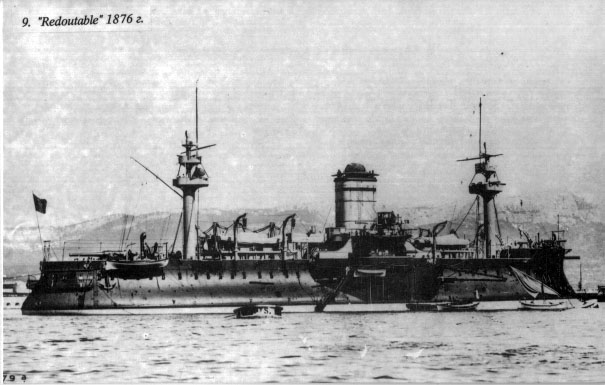
Retoutable after refit
She was sent in September for her major refit in Toulon, and afterwards was sent to the Atlantic squadron based in Brest. Among others, her armamement was completely revised, she had new military masts fore and aft while her rigging as deposed, and modifications made to her armor, with add-ons to protect her from parabolic fire. All in all, these additions made her heavy compared to her original design. The strain would have been immense if all of her eight main guns were would have fired at the same time. In 1894 she was also completely reboilered, with a more modern setup: She received brand new 8 cylinder boilers. However if it’s augmented her output it’s not clear her speed rose due to her larger displacement.
She made the first tests of transmission of electric radio signals (wireless telegraphy) in the harbor after refit. Her captains were, in order, in 1879 when completed and trialled, Captain Rallier, followed in 1881 by Captain Behic, in 1883 by de Boissondy, 1885 by de Slane, 1887 by de Libran, 1889 by Dieulouard and in 1892 by Captain Chateauminois.
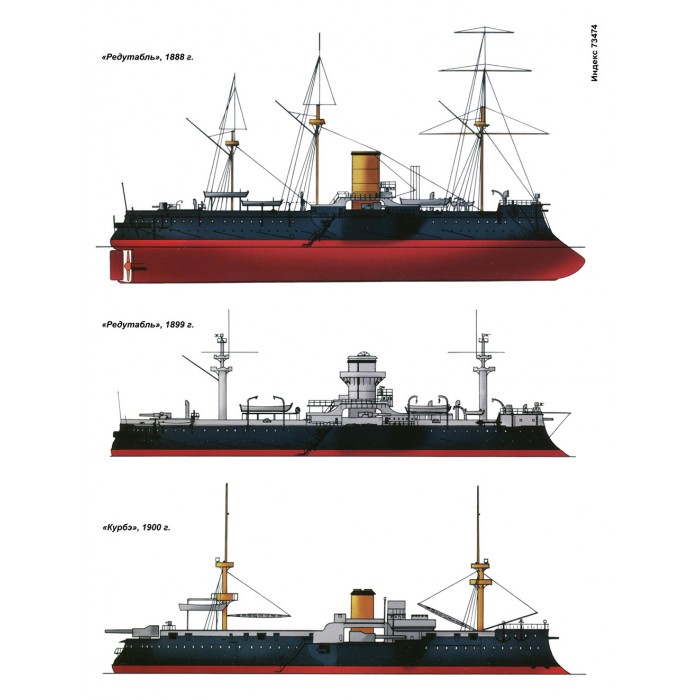
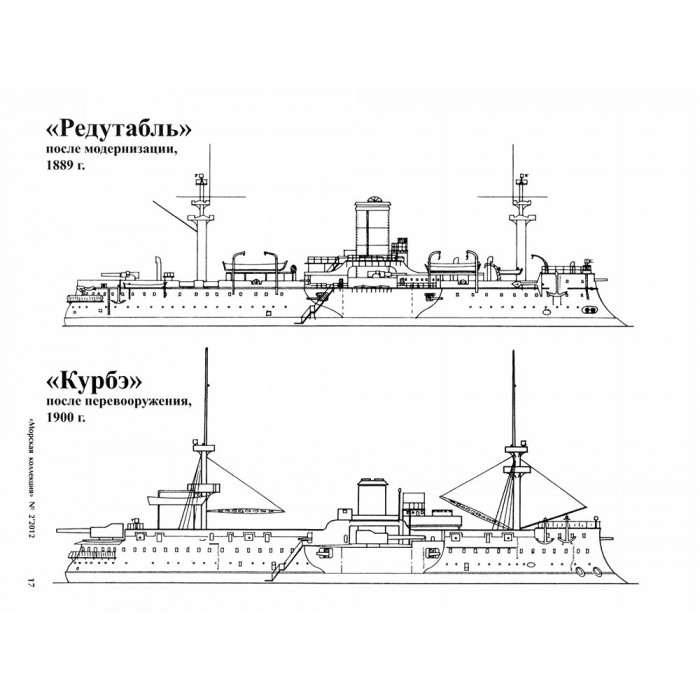
In 1894 her machinery was replaced by eight cylindrical boilers, with one VTE. For the armament she had now three 274mm/20 guns, four single 240mm/29, six single 139mm/21, and later three 3 274mm/40 M1893-96, four 240mm/30 M1884 and six single 100mm/45 M1891. Her last armment before she was stricken, comprised just seven 37mm/20 and five 65mm/50 M1891, fourteen 47mm/40 M1885 and finally just five 37mm/20 M1885 guns. He appearance was wildly different as she had no rigging left, and a more developed bridge with searchlights.
From the time she was out of drydock for her post-refit trials, she was commanded by Captain Billard from 1895. Her was replaced in 1896 by Captain Mallarmé and from 5 September 1898 by Captain Esmez. By that time she had served in the same squadron but was scheduled to steam for the Indian Ocean. She was to take service in Asia and the Indian Ocean, and was based for some time in Saigon. For her first trip this year, she stopped in Suez, Djibouti, Colombo, Singapore. At the time, Courbet and the French fleet were in full colonial conquest in Anam and Tonkin (Future “indochina”).
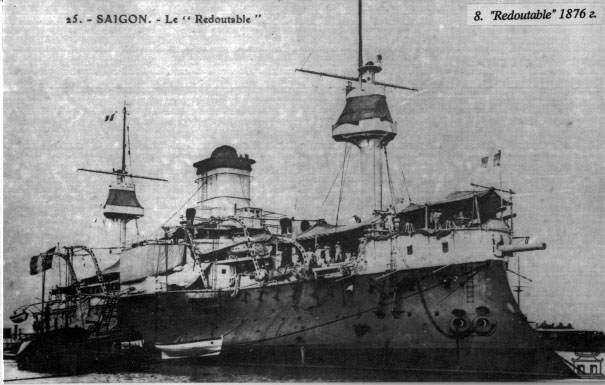
Retouable in Saigon, circa 1905-1910
In 1900, due to the Boxer revolt in China, she is sent in the far east, making a long trip from Cherbourg to the Taku Forts at the avergage cruise speed of 12 knots, as flagship, carrying the Admiral Pottier flag. On 21 July 1900 her new captain was Captain Neny, replaced in 3 December 1901 by Duroch. She was based in Saigon and operated notably in the Along Bay in 22-26 january 1903. From 15 October 1903 Captain Poidloue took command.
She became a permanent par of the Indochina naval division in 1905. In 1906 Captain Passerat de Sillans took command and on 5 December 1907 Captain Drouet, replaced in 1909 by Lieutenant Arnauld, but at the time she was in limited service with a reduced crew. She was eventually placed in reserve until 1909 and stricken on 9 mars 1910, in Saigon. She was broken up in situ in 1912-1913. This was quite a long service life, in part explained by her partial steel hull.
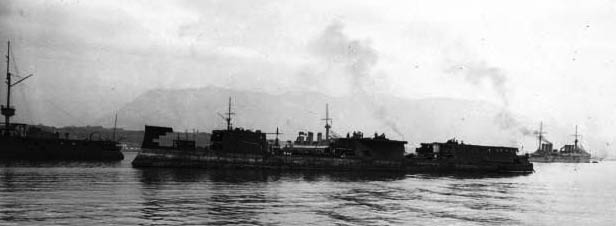
Redoutable in Toulon, dismantled, 1912
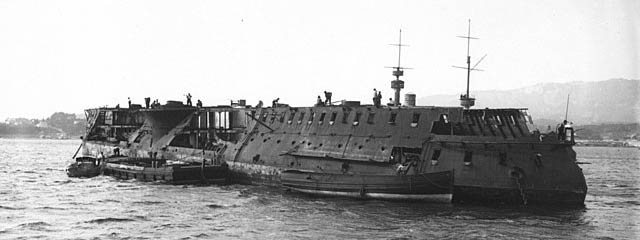
Same, photo from agence Rol
Read More/Src
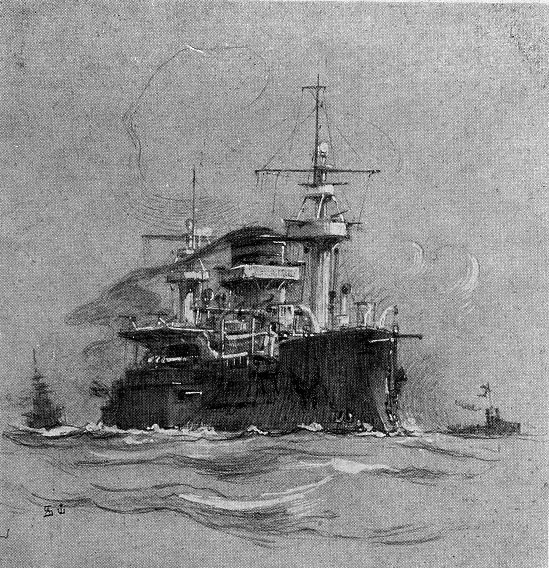
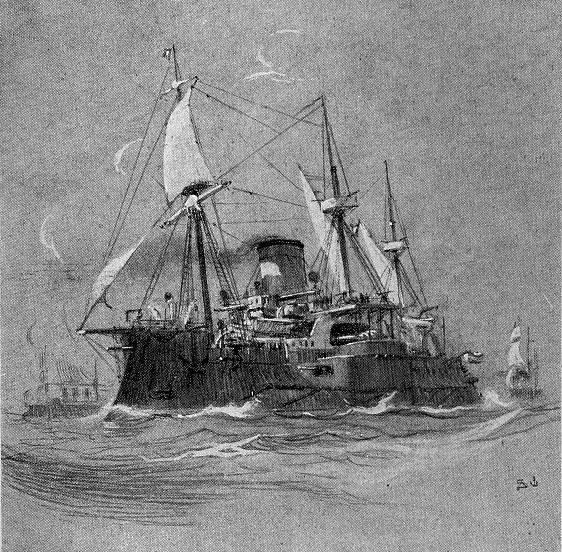
Engraving of Redoutable as completed, with rigging
Sites
On several French ironclads and battleships
Navypedia
The Redoutable on battleships-cruisers.co.uk
The construction of ironclads
Le Redoutable wiki FR
On Wikipedia EN
CC photos
Colorized photo of the ship after refit in 1899 – Postales Navales
On battleships.spb.ru
cartacaro.fr Le Redoutable in Indochina, 1900-1908
Books
Éric Gille, Cent ans de cuirassés français. Nantes, Marines éditions june 1999
Roger Chesneau, Eugene M. Koleśnik, Conway’s All the World’s Fighting Ships 1860-1905
Marc Saibène “Les cuirassés redoutable, dévastation, courbet”, Marines Editions (Now all sold)
Marc Saibène “Cuirassé le Redoutable 1876-1910” Neptunia Association des amis du musée de la marine Paris AAMM 1936
Roche, Dictionnaire des bâtiments de la flotte de guerre française
Saibène, The Redoubtable, Part I, Warship International, No 1, 1994
Saibène, The Redoubtable, Part III, Warship International, No 1, 1995
Saibène, Les Cuirasses Redoutable, Dévastation, Courbet, Programme de 1872
Conway Marine, “Steam, Steel, and Shellfire”
Scientific American 1881
The Models corner
MKL-201202 Naval Collection 02/2012: Redoutable-class French ironclads
Hai 342N model
Gallery
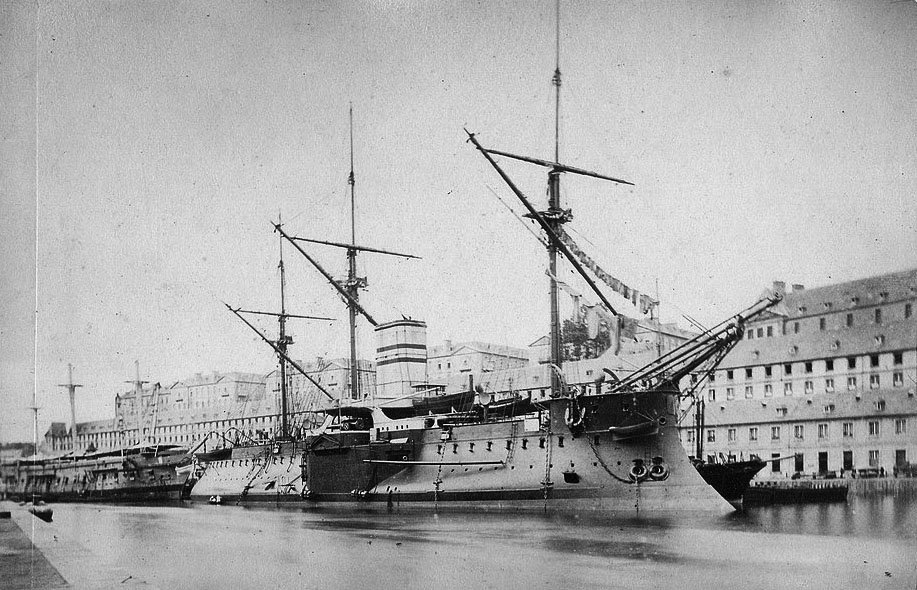

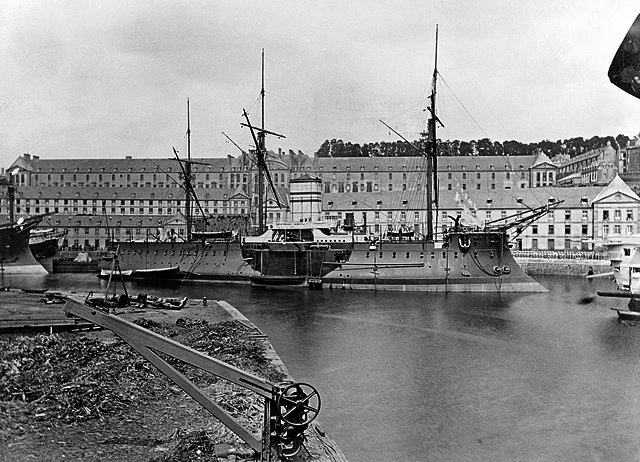
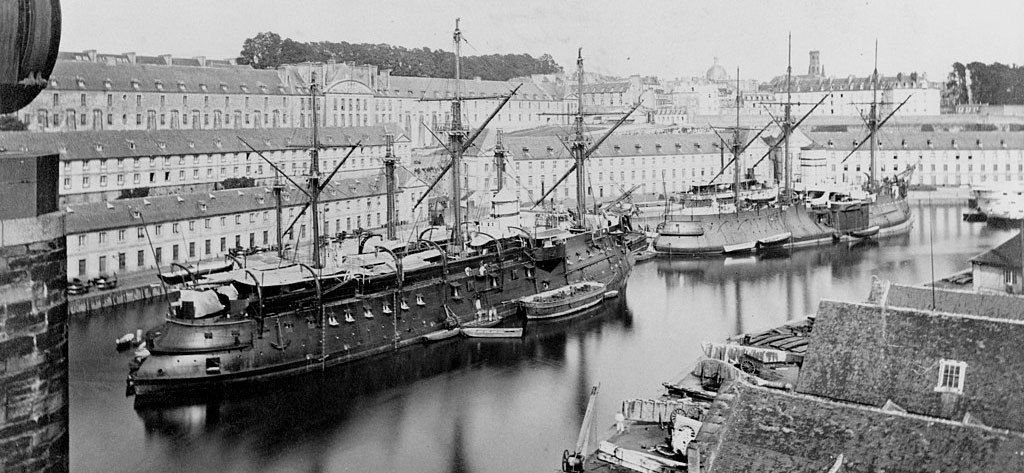
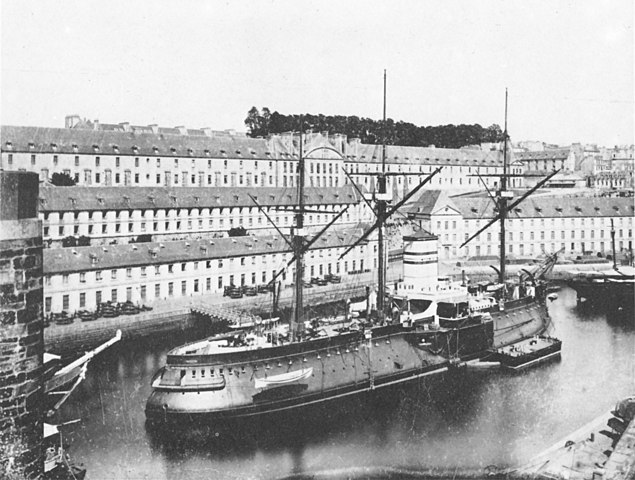
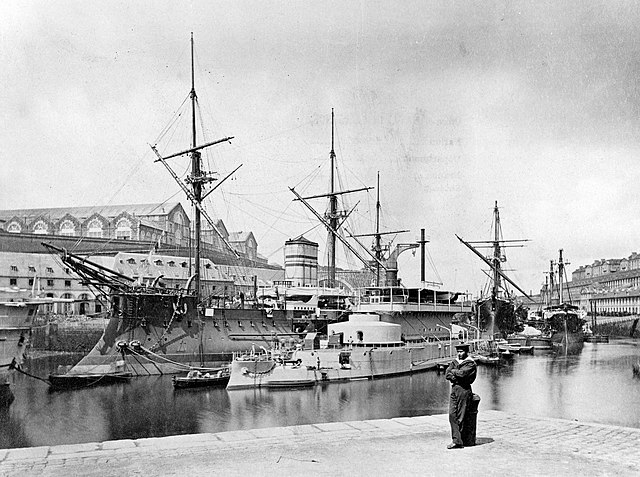
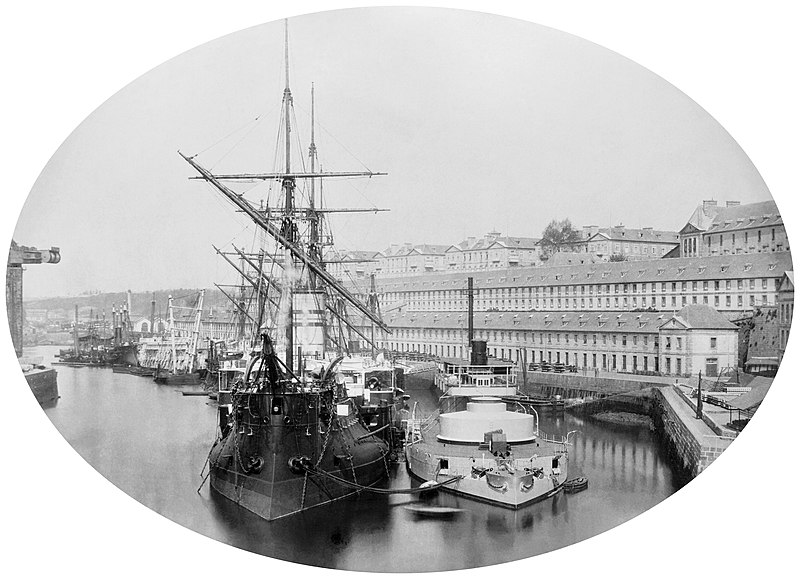
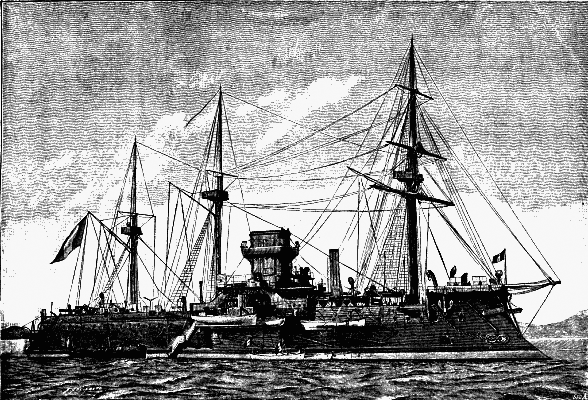
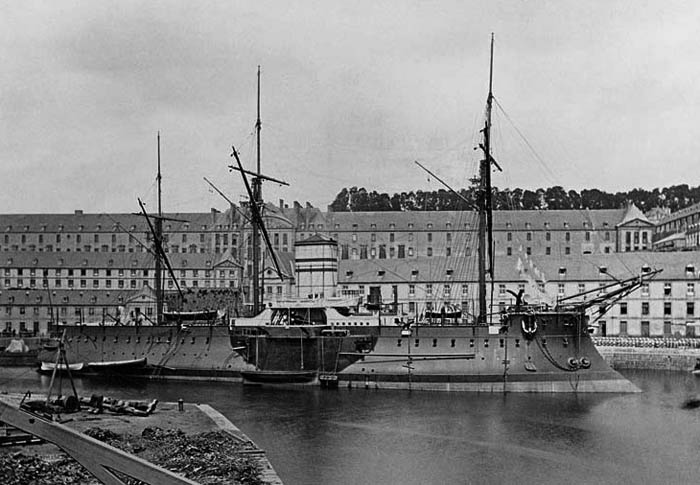
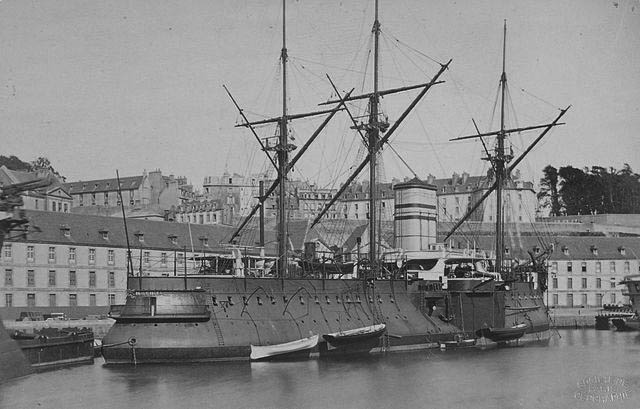
Various photos of Le Redoutable at Penfeld, Brest, by James Jackson.

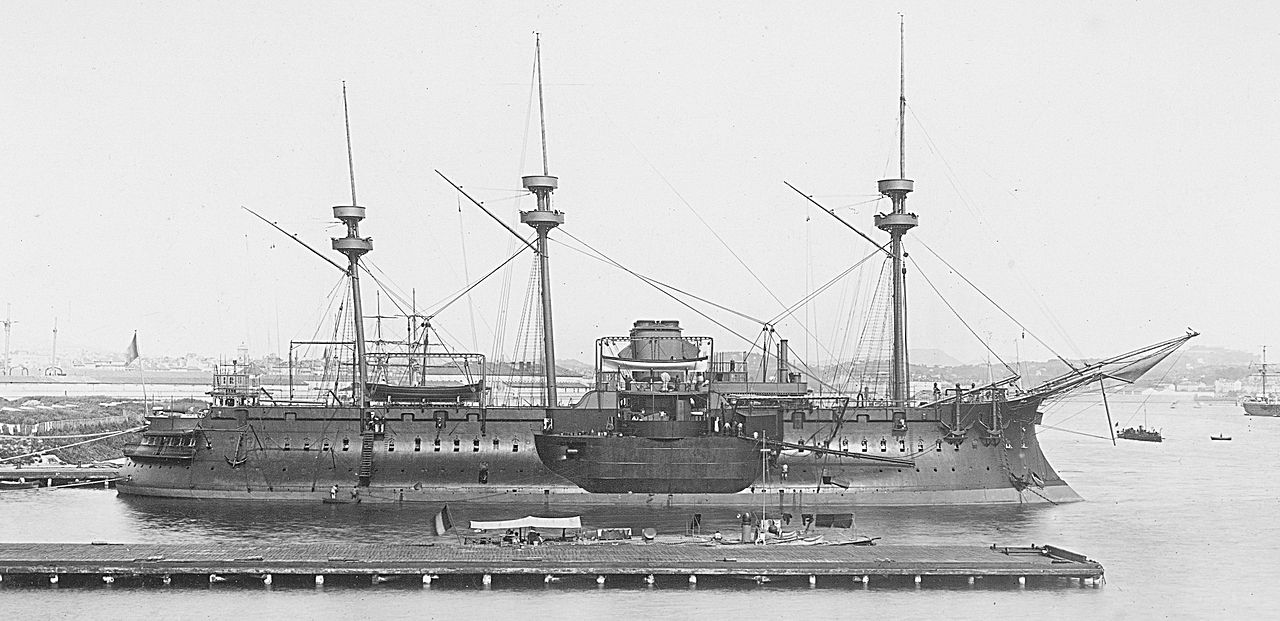

 Latest Facebook Entry -
Latest Facebook Entry -  X(Tweeter) Naval Encyclopedia's deck archive
X(Tweeter) Naval Encyclopedia's deck archive Instagram (@navalencyc)
Instagram (@navalencyc)





 French Navy
French Navy Royal Navy
Royal Navy Russian Navy
Russian Navy Armada Espanola
Armada Espanola Austrian Navy
Austrian Navy K.u.K. Kriegsmarine
K.u.K. Kriegsmarine Dansk Marine
Dansk Marine Nautiko Hellenon
Nautiko Hellenon Koninklije Marine 1870
Koninklije Marine 1870 Marinha do Brasil
Marinha do Brasil Osmanlı Donanması
Osmanlı Donanması Marina Do Peru
Marina Do Peru Marinha do Portugal
Marinha do Portugal Regia Marina 1870
Regia Marina 1870 Nihhon Kaigun 1870
Nihhon Kaigun 1870 Preußische Marine 1870
Preußische Marine 1870 Russkiy Flot 1870
Russkiy Flot 1870 Svenska marinen
Svenska marinen Søværnet
Søværnet Union Navy
Union Navy Confederate Navy
Confederate Navy Armada de Argentina
Armada de Argentina Imperial Chinese Navy
Imperial Chinese Navy Marinha do Portugal
Marinha do Portugal Mexico
Mexico Kaiserliche Marine
Kaiserliche Marine 1898 US Navy
1898 US Navy Sovietskiy Flot
Sovietskiy Flot Royal Canadian Navy
Royal Canadian Navy Royal Australian Navy
Royal Australian Navy RNZN Fleet
RNZN Fleet Chinese Navy 1937
Chinese Navy 1937 Kriegsmarine
Kriegsmarine Chilean Navy
Chilean Navy Danish Navy
Danish Navy Finnish Navy
Finnish Navy Hellenic Navy
Hellenic Navy Polish Navy
Polish Navy Romanian Navy
Romanian Navy Turkish Navy
Turkish Navy Royal Yugoslav Navy
Royal Yugoslav Navy Royal Thai Navy
Royal Thai Navy Minor Navies
Minor Navies Albania
Albania Austria
Austria Belgium
Belgium Columbia
Columbia Costa Rica
Costa Rica Cuba
Cuba Czechoslovakia
Czechoslovakia Dominican Republic
Dominican Republic Haiti
Haiti Hungary
Hungary Honduras
Honduras Estonia
Estonia Iceland
Iceland Eire
Eire Equador
Equador Iran
Iran Iraq
Iraq Latvia
Latvia Liberia
Liberia Lithuania
Lithuania Mandchukuo
Mandchukuo Morocco
Morocco Nicaragua
Nicaragua Persia
Persia San Salvador
San Salvador Sarawak
Sarawak Uruguay
Uruguay Venezuela
Venezuela Zanzibar
Zanzibar Warsaw Pact Navies
Warsaw Pact Navies Bulgaria
Bulgaria Hungary
Hungary

 Bundesmarine
Bundesmarine Dutch Navy
Dutch Navy Hellenic Navy
Hellenic Navy Marina Militare
Marina Militare Yugoslav Navy
Yugoslav Navy Chinese Navy
Chinese Navy Indian Navy
Indian Navy Indonesian Navy
Indonesian Navy JMSDF
JMSDF North Korean Navy
North Korean Navy Pakistani Navy
Pakistani Navy Philippines Navy
Philippines Navy ROKN
ROKN Rep. of Singapore Navy
Rep. of Singapore Navy Taiwanese Navy
Taiwanese Navy IDF Navy
IDF Navy Saudi Navy
Saudi Navy Royal New Zealand Navy
Royal New Zealand Navy Egyptian Navy
Egyptian Navy South African Navy
South African Navy






























 Ukrainian Navy
Ukrainian Navy dbodesign
dbodesign